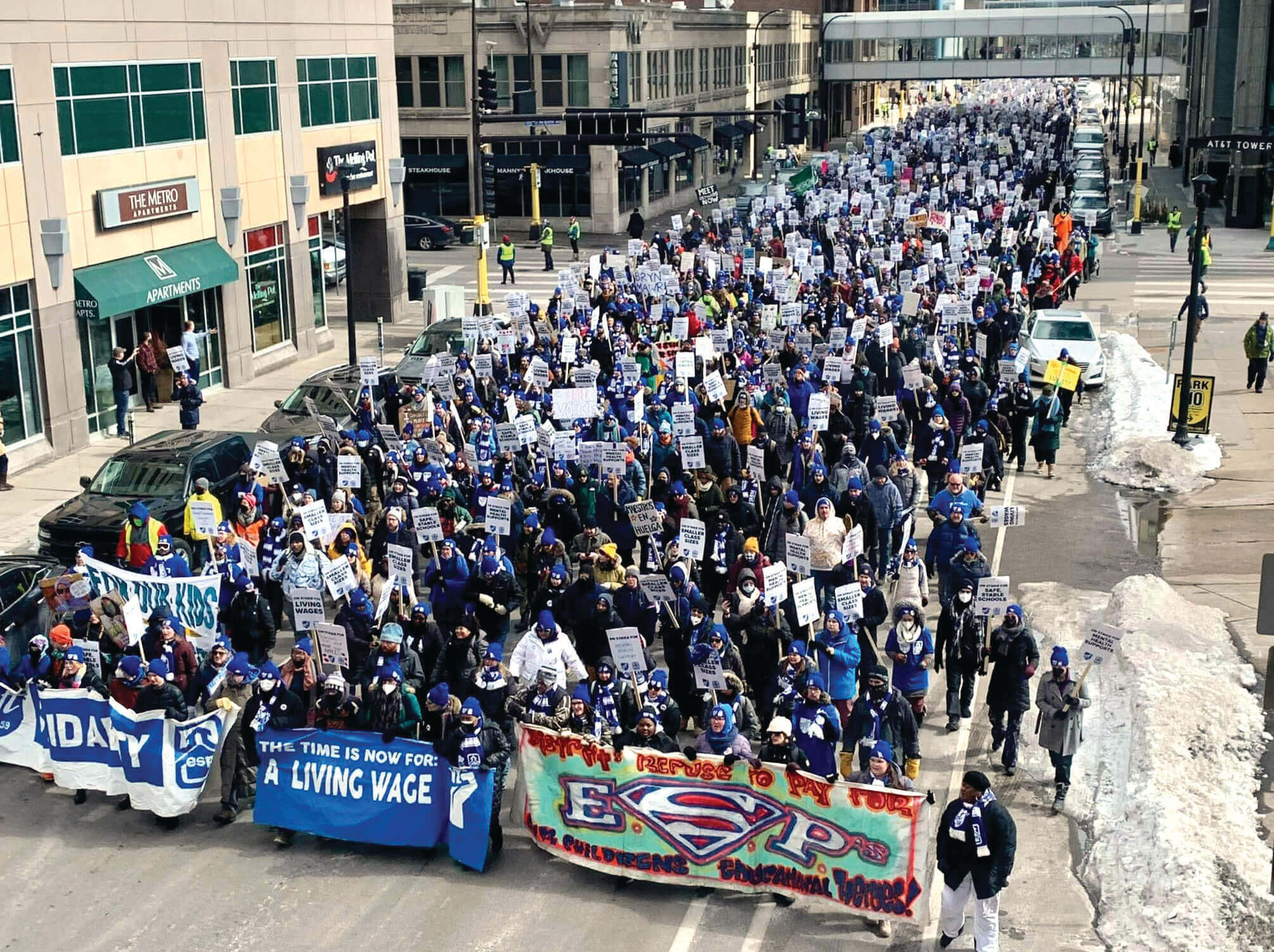The Minneapolis Federation of Teachers and Education Support Professionals teacher and education support professional chapters went on strike March 8, the first educator strike in the city in 52 years.

As of press time, the union’s two bargaining units of more than 4,000 members were still out on strike.
“We’ve got teachers and ESPs and RSPs in Minneapolis working together like never before,” said Shaun Laden, MFT ESP chapter president. “This time, it’s different.”
The ESP and teacher units are each bargaining their own contract, but they are doing it together to support each other and fight for a more systemic change in the district.
“After 50 years of knowing this isn’t right or isn’t feeling good, we’re in this place where we can take some real action,” said Greta Callahan, MFT teacher chapter president.
“What’s been really powerful is our local decided we wanted to do things differently after the last few bargaining cycles and how things have gone,” said Laden. “We really shifted our local mindset that bargaining is more about how prepared we are in our buildings.”

The strike comes after 13 months of negotiations and mediation with Minneapolis Public Schools.
The strike authorization votes were held in school buildings in mid-February for four days.
The teacher chapter had a 96 percent turnout and 97 percent said yes.
The ESP chapter had a 93 percent turnout of their members and 98 percent voted yes.
Both units saw membership rise in anticipation of the strike. The ESP chapter saw more than 200 new members sign up so they could participate in the vote and strike.
“This is a statement from thousands and thousands of educators supporting over 30,000 students that it doesn’t have to be this way, and we’re going to do something about it,” said Callahan, the night of the vote announcement.
MFT is calling their strike action a call for “Safe and Stable Schools.”
Their major asks are:
A living wage for ESPs.
Contract language that calls for recruitment and retention of educators of color.
More mental health staff to improve student-to-staff ratios.
Contract language for class size caps.
Competitive compensation to retain licensed staff.
“Our students and educators continue to do so much more with so much less and those at the top continue to less with so much more,” said Callahan. “Our students can’t afford to lose another great educator. Our students can’t afford to sit in classrooms with 45 other students trying to learn.”

ESP pay is the top priority for both units.
“Education support professionals are not being paid living wages. More than 70 percent of our members are working second and third jobs,” said Mikel Herb, a Minneapolis ESP. “We’re just asking to earn a living wage and work one job.”
“ESPs keep the school running,” said Patience Dolo, a counselor at North High School. “If they get a raise, that’s what is most important.”
Recruitment and retention of educators of color is also a top priority, so that the staff of Minneapolis schools looks more like its students.
“Our hourly workers are our most diverse workforce,” said Laden. “We talk a lot about equity in our district, and one of the biggest things we can do to improve equity and provide equity in our district is to pay our hourly workers a living wage.”
The union’s proposals for supporting educators of color include a mentoring program where educators of color would have mentors of color, professional development to disrupt and dismantle racist behaviors, exit interviews for any educator of color with a process for repairing harm, and culturally responsive support for educators of color to increase retention and success.
“We are hopeful district leaders will be ready to enact systemic changes to recruit and retain educators of color within our contract versus band aids,” said Edward Barlow, a teacher and negotiations team member.
The strike comes after particularly tough bargaining taking place in the context of a once-in-a-generation pandemic.
In January 2021, after attempts to bargain over teacher and ESP working conditions during the pandemic, MFT filed an unfair labor practice charge with the Public Employment Relations Board against Minneapolis Public Schools.
Also in January 2021, the union filed a motion for a civil injunction over issues around returning to in-person learning. The Hennepin County Fourth Judicial District Court ruled that the Minneapolis Public School District could not require staff to return to work in person if they had previously received or are in the process of obtaining an accommodation to work from home.
“We don’t have a budget crisis in Minneapolis Public Schools,” said Laden. “We have a values and a priorities crisis.”
During the strike, educators picket at school sites across the city each morning and often come together for a mass action midday – rallying at the State Capitol, in downtown Minneapolis and at the district headquarters.
“The solidarity and the unity that we feel and the support from the community has been amazing,” said Stephanie Schreiner, an academic coach at Jenny Lind Elementary.
At the rallies, members of the bargaining team spoke about what was happening during mediation.
“At the bargaining table, the district wants to share space, but not power,” said Daniel Perez, a teacher and negotiator. “We are the people in the classrooms closest to the students. We should have a seat at the table.”
Educators also did multiple shifts of door knocking in the neighborhoods of their community, talking with parents and others about why they were out on strike and how the public could support them.
Educators and community members also gathered to write letters to the school board and superintendent.
Out on the strike lines, the message was clear: This is a joyful and powerful fight. A message that educators hope will carry on throughout the future of MFT and MPS.
“This is just as much for us as it is for future teachers,” said North High School math teacher Tyler Salone. “This isn’t just a change for us but for the future.”


